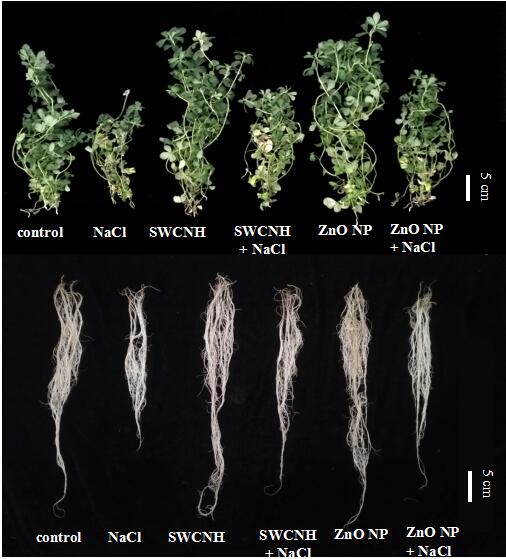Sophora alopecuroides is an important traditional Chinese medicine. Salt stress, as one of the most hampering abiotic factors, can severely affect plant growth and crop yield. It is of great significance to improve the salt tolerance of S. alopecuroides for increasing yield and quality, and thereby promoting the local sustainable development of agriculture.
In a study published in Environmental Science: Nano, researchers from Xishuangbanna Tropical Botanical Garden (XTBG) and their collaborators showed the promoting effects of single-walled carbon nanohorns (SWCNHs) and ZnO nanoparticles (ZnO NPs) on plant growth and salt tolerance in Sophora alopecuroides seedlings.
Physiological approaches integrated with metabolomics analysis were performed to investigate the underlying mechanisms of ZnO NP- and SWCNH mediated salt stress responses in S. alopecuroides.
They showed that changes in metabolomic profiling by SWCNHs and ZnO NPs contributed to salt tolerance in Sophora alopecuroides seedlings. Compared with untreated control plants, foliar spraying with SWCNHs increased root length, root fresh weight and leaf soluble sugar content; while ZnONPs increased root fresh weight, leaf dry weight and soluble sugar content, indicating that the two engineering nanomaterials (ENMs) improved the growth of S. alopecuroides seedlings.
“These results suggested that the application of the two ENMs provided a novel way to improve salt tolerance in plants,” said Dr. WAN Jinpeng, first author of the study.
“Future study on the investigation of the changes of gene expression and metabolic profiling in full life cycle will provide stronger evidences for the use of the two ENMs in sustainable agricultural strategies for crop cultivation,” added WAN.
Contact
WAN Jinpeng Ph.D
Key Laboratory of Tropical Plant Resources and Sustainable Use, Xishuangbanna Tropical Botanical Garden, Chinese Academy of Sciences, Menglun 666303, Yunnan, China
E-mail: wanjinpeng@xtbg.org.cn

SWCNHs and ZnO NPs alleviated salt-induced growth inhibition.
Five-week-old seedlings were transferred to fresh 1/2 Hoagland solution
with 100 mM NaCl (NaCl) or without (control) salt stress,
and the seedlings were foliar sprayed with 50 mg/L SWCNH or 100 mg/L ZnO NP for 15 days.
The representative images show the growth of leaves and roots. (Images by WAN Jinpeng)

